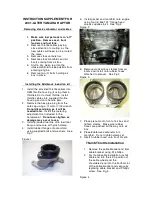
3. Tire size designed for your vehicle.
4. Cold tire inflation pressures for the front, rear, and
spare tires.
Loading
The vehicle maximum load on the tire must not exceed
the load carrying capacity of the tire on your vehicle. You
will not exceed the tire’s load carrying capacity if you
adhere to the loading conditions, tire size, and cold tire
inflation pressures specified on the Tire and Loading
Information placard in “Vehicle Loading” in the “Starting
And Operating” section of this manual.
NOTE:
Under a maximum loaded vehicle condition,
gross axle weight ratings (GAWRs) for the front and rear
axles must not be exceeded. For further information on
GAWRs, vehicle loading, and trailer towing, refer to
“Vehicle Loading” in the “Starting And Operating” sec-
tion of this manual.
To determine the maximum loading conditions of your
vehicle, locate the statement “The combined weight of
occupants and cargo should never exceed XXX lbs or
XXX kg” on the Tire and Loading Information placard.
The combined weight of occupants, cargo/luggage and
trailer tongue weight (if applicable) should never exceed
the weight referenced here.
Steps For Determining Correct Load Limit
1. Locate the statement “The combined weight of occu-
pants and cargo should never exceed XXX lbs or
XXX kg” on your vehicle’s placard.
2. Determine the combined weight of the driver and
passengers that will be riding in your vehicle.
3. Subtract the combined weight of the driver and pas-
sengers from XXX lbs or XXX kg.
466
STARTING AND OPERATING
Summary of Contents for Charger 2016
Page 4: ......
Page 7: ...1 INTRODUCTION 5...
Page 10: ......
Page 258: ......
Page 266: ...INSTRUMENT CLUSTER PREMIUM Instrument Cluster For 6 4L 264 UNDERSTANDING YOUR INSTRUMENT PANEL...
Page 470: ...468 STARTING AND OPERATING...
Page 520: ......
Page 625: ...MAINTENANCE SCHEDULES CONTENTS MAINTENANCE SCHEDULE 624 Maintenance Chart 626 8...
Page 632: ......
Page 644: ......
Page 645: ...INDEX 10...
















































